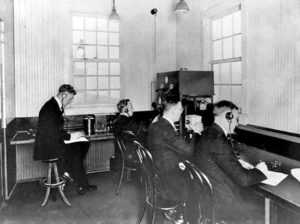There is an invisible marketing tool that is often overlooked; and that’s the power of sound.
In the beginning, there was a voice. When you were born, one of the first voices to grace your eardrums was your mother’s. It has been proven that a mother’s voice to her child is so powerful that it activates many different regions of the child’s brain. Some even compare a mothers voice to a hug as it invokes the same type of emotions and positive hormonal reactions as a hug does.
What does this have to do with marketing? More than what meets the…ears, if you will. It’s no surprise that a marketing genius figured out how to use sounds to their advantage. But let’s back it up a bit, to 1886 to be exact, when Heinrich Rudolf Hertz successfully invented a radio waves transmitter. This was the first successful attempt after discovering the existence of electromagnetic waves moving at the speed of light. Not long after, a man named Guglielmo Marconi created long-distance radio transmissions, and is known and credited as the inventor of the radio.
The early 1900’s brought us the first commercial radio broadcast on the topic of the Harding Cox Election results, voiced by radio’s first announcer, Leo Rosenberg. At this point in the game, the broadcasters didn’t even know how far their transmission would reach. After all was said and done, the election results were relayed to about 1,000 listeners through this incredible new medium.

The potential of broadcast radio skyrocketed, opening the floodgates for radio personalities. “The Shadow”, one of the first and most iconic radio shows in history, aired August 1930.

“Who knows what evil lurks in the hearts of men? The Shadow knows!”
These were the opening lines of the “Detective story” program that left listeners in awe, and is instantly recognizable by radio buffs to this day. The radio show is popularly known as “the Shadow” voiced by Orson Welles.
You know those actors that only have to speak a few syllables and you already know who they are? The voices that take you somewhere else – somewhere comforting, eerie or empowering, or perhaps all of those emotions at once. That is the strength of a powerful voice. Morgan Freeman is a great example of this. I almost know his voice better than his face.
What about the very deep, western voice you’ve heard on commercials for Dodge and Coors beer? You may not know his name, but the rich and masculine voice of Sam Elliott is unmistakable:
The sound of voice influences us in many ways, but what about the tunes that we just can’t seem to get out of our heads? I know they seem pointless and annoying when you’re trying to sleep or focus, however, they prove to be tremendously useful memory devices for marketers. I hope I’m not the only one that remembers the ridiculous radio song about mattresses, or what to do when you’re drunk trying to remember the cab number – don’t worry, there’s an annoying jingle for that.
The first jingle was created by Wheaties and aired Christmas Eve, 1926 on WCCO in Minneapolis. Jingles are now a very popular method of advertising, but in the beginning there were some concerns from consumers. The ad had to get by NBC radio rules and guidelines, which strictly prohibited direct sales messages in advertisements. Wheaties overcame this obstacle by urging listeners to “try” Wheaties instead of directing them to buy.
Jingles have grown in popularity since, many of which were written by Barry Manilow. If the name doesn’t ring a bell, I’m sure one of his jingles will. Barry wrote and sang some of the catchiest jingles in history. Some of the jingles he created have become so identifiable with the corresponding brand that they are still being used presently. Here are a couple of his greatest works:
Bandaid – Stuck on Bandaid brand
Mcdonalds – You Deserve a Break Today
Today, the McDonald’s jingle we know and love was brought to us by Justin Timberlake. Mind you, it’s a lot shorter than the original McDonalds jingle.
Which brings us to the future of sound: when we think of brands, we imagine logo’s, look and feel of the brand and company values. Companies want to get their brand & brand message out there through as many avenues as possible. A cunning way brands are taking advantage of sound is the motif.
A motif in advertising and branding is a short sequence of notes producing a single impression. In laymen’s terms, it’s the little tune you might hear in a commercial, before a movie starts, or when turning on a computer or phone. This “tune” is heavily strategic and is used to relay emotions or feelings around a specific brand. 31% of Internet users have the TV on in the background, and more than 80% of people use the TV and internet simultaneously. It only makes sense to attach sound to your brand whenever possible.
adHOME put together a motif for fun that we feel does a good job at encompassing our brand identity. Eventually, we’d like to create an original motif to express our brand as we’ve seen the power sound has over us.